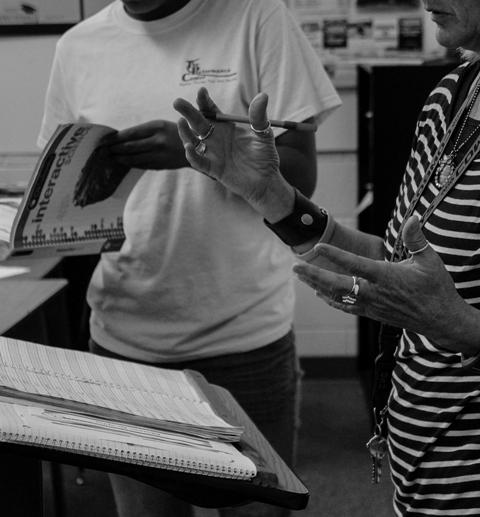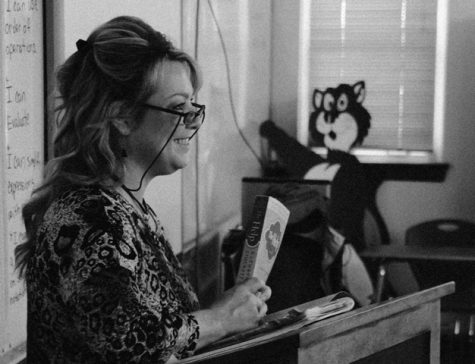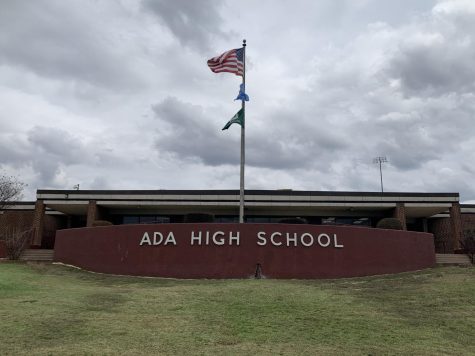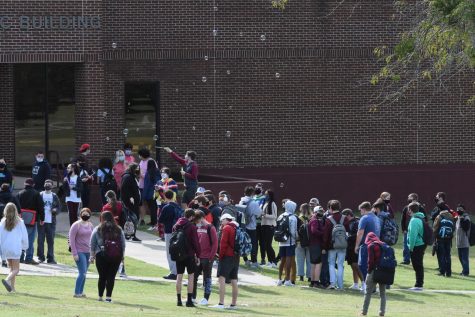Education budget crisis affects local schools

Oklahoma teachers, including Ada Junior High teacher Lynda Roberts, were disappointed in the failure of State Question 779 and continue to have little faith in the funding of a pay raise for teachers as the education budget crisis continues. “Teachers needed something to keep them from leaving or finding another job. I have grandchildren that I would like to be taught by certified teachers and that is not looking like it will happen,” Roberts said.
Since the 2008 recession, Oklahoma schools have been struggling with the budget crisis, and continued cuts to education funding aren’t giving educators or students much hope for a resolution.
Deanna Compton teaches English at Ada High School and is in her twentieth year in the teaching profession. Compton has noticed an increase in her workload, directly related to cuts in education funding.
“The English department has to ask for outside donations to purchase novels or tape together ones that are falling apart,” said Compton, who is currently teaching three different novels to students enrolled in the same subject, just to ensure that each student has a book to use. “It’s much more time consuming to teach three at once.”
According to okpolicy.org, Oklahoma leads the nation in deepest cuts to its school funding. Per student funding dropping a total of 23.6 percent over the past six years, the school average Oklahoma school system has had to absorb these cuts to funding while still trying to ensure that students receive the education they need. Despite the slowly recovering economy, Oklahoma, one of twenty states with continued cuts to funding, has steadily dropped in per student spending, now falling $875 below pre-recession levels after inflation.
Oklahoma legislature, under the helm of Governor Mary Fallin, provided a $41 million annual budget increase to school funding this year, however, with Oklahoma’s rising student enrollment and inflation, this increase isn’t enough to keep up with the cost. This has resulted in many Oklahoma schools to incorporate a four day school week, a topic that has caused a great deal of debate, especially in light of Fallin’s comments that schools should “step up” regarding her push for a five day school week.
Decreased student funding is not the only adverse effect of the education budget crisis. This decrease has ramped up the debate over teacher pay, making it difficult for Oklahoma to fund teacher raises, despite the recent law guaranteeing Oklahoma teachers a $6000 per year raise, to be distributed over three years.
A recent newsok.com article reported that in the last year alone there has been a total loss of 1530 teaching positions in Oklahoma because of the lack of funding. A report from the Oklahoma State School Boards Association released in August, revealed that an additional 351 support staff positions have been also been eliminated over the past year.
Ada High School is certainly no exception to these budget cuts. After the spring 2016 budget cuts, the school year was shortened by a full week to help absorb some of the impact of these budget cuts. However, according to principal Jeff Maloy, this year teaching positions may be eliminated.
“We are looking to possibly find a way to teach what we’re teaching with fewer teachers,” Maloy said. “We’re not looking at creating a rift/relieving teachers, as in not firing, but we will not be replacing teachers that retire and will be adding duties and teaching assignments to teachers already here.”
These increased duties may have a devastating impact on already over-worked teachers. According to Compton, the stress levels of her job have increased as education funding has decreased.
“Above all, just the emotional [and] mental drain of not feeling supported and worrying about the future, is perhaps taking the biggest toll,” said Compton.
The impact of these cuts on Oklahoma schools looks to continue into the next school year according to a report from the National Education Association. It is indicated that President Trump announced in March that his initial budget proposal for 2018 will include a 13.5 percent, or $9 billion, cut to the Department of Education, setting education funding levels back to pre-2002 levels. This new budget from the Trump/DeVos agenda also eliminates funding for Title II (the teacher training grant program), after school programs and student grant aid. Colleges and universities will feel these funding cuts in the areas of Pell Grants, TRIO, GEAR UP and student work aid.
As stated by okea.org, Oklahoma schools have an estimated total loss of $47 million in federal student aid and a loss of as many as 1226 jobs. This directly affects more than 100,000 of the state’s students.
Ada High psychology teacher Cara Waters has had the experience of teaching both in Oklahoma and Texas and fears the trends in Oklahoma will cause irreparable damage to both students and teachers.
“Lack of funding means lack of access our 21st century learners have to develop the computer literacy skills essential to compete in the work world or to be successful as they continue at a post-secondary institution,” Waters said, also noting a decrease in class and elective offerings.
The biggest cuts have been made to the following Oklahoma programs:
- Title 1 Grants with an estimated loss of $13.9 million and 220 jobs
- Special Needs Education Grants for children pre-k through twelfth grade with an estimated loss of $12.8 million and 205 jobs
- Vocational Rehabilitation Grants with an estimated loss of $3.6 million and 30 jobs
- Career Technology Grants with an estimated loss of $11.4 million and around 22 jobs
- Head Start Grants with an estimated loss of $8.2 million and 540 jobs
The education crisis, which looks to continue, leaves Oklahoma schools to make more difficult decisions in an attempt to find funds, striving to provide the best education possible for their students. Teachers are now forced to rely on the kindness of strangers, many turning to a Facebook group, Oklahoma Education Needs/Donations, for basic needs like pencils and copy paper. The group was created by a parent in an effort to match struggling teachers with Oklahomans looking to help.
Waters, who is familiar with this Facebook group, worries that if this continued lack of government support continues, leaving citizens to bear the burdens of education funding, more and more qualified educators will continue to leave Oklahoma, instead opting to teach in surrounding states. “Quality educators [may] choose to teach in states that pay better, which is every other state.”

Becky Robnett is a Senior Editor, Reporter, and Columnist for The Cougar Call at Ada High School. She also participates in Ada High's Band, is in her third...

Mackenzee Crosby is a senior columnist and photographer for The Cougar Call. She is very down to earth and kind. Mackenzee enjoys taking photos, blogging,...















